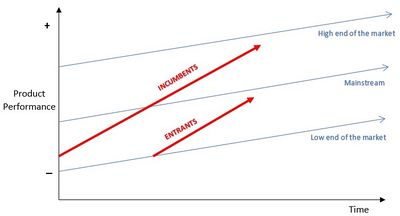Disruptive innovation
| Disruptive innovation |
|---|
| See also |
Disruptive innovation is an innovation that creates a new market and eventually disrupts an existing market, displacing established market-leading firms and products. It is not driven by the market, but it is a completely different way of delivering a product that consumers are used to. The term was defined and first analyzed by the American scholar Clayton M. Christensen and his collaborators beginning in 1995 (Rahman Airini et al. 2017).
Incumbent vs Entrants
Disruption describes a process whereby a smaller company with fewer resources (Entrants) is able to successfully challenge established business (Incumbents). As incumbents focus on improving their products and services for their most demanding customers, they exceed the needs of some segments and ignore the needs of others. Entrants that prove disruptive begin by successfully targeting those overlooked segments, gaining a foothold by delivering more suitable functionality frequently at lower price. Incumbents, pursuing higher profitability in more-demanding segments, tend not to respond strongly. Entrants then move upmarket, delivering the performance that incumbents’ mainstream customers require, while preserving the advantages that drove their early success. When mainstream customers start adopting the entrants’ offerings in volume, disruption has occurred (Christensen, C. M. et al. 2015).
Sustaining vs Disruptive
Disruption theory differentiates “disruptive innovations” from what are called “sustaining innovations.” (Bower, J. L., & Christensen, C. M. 1995). The latter targets demanding high-end customers, make good products better in the eyes of an incumbent's existing customers: the fifth blade in a razor, the clearer TV picture, better mobile phone reception. These improvements can be incremental advances, year-by-year improvements or major breakthroughs, however it doesn't matter how technologically difficult the innovation is, this strategy enables firms to sell more products to their most profitable customers and established competitors almost always win because they have the resources to do it (Christensen, C.M. 2013). Disruptive innovations, on the other hand, don't attempt to bring better products to established customers in existing markets.
Rather, they disrupt and redefine the market by introducing products and services that are not as good as currently available products. So that, they are initially considered inferior by most of an incumbent's customers. But disruptive innovations offer other benefits, they are simpler, more convenient, and less expensive products that appeal to new or less-demanding customers (Christensen C.M. 2019). Typically, customers are not willing to switch to the new offering merely because it is less expensive, instead, they wait until its quality rises enough to satisfy them. Once it is happened, they adopt the new product and accept its lower price.
Disruptive innovation model
This diagram contrasts product performance trajectories represented by the red lines showing how products or services improve over time, with customer demand trajectories, that is a rate of improvement that customers can utilize or absorb represented by the blue lines showing customers’ willingness to pay for performance. As incumbent companies introduce higher-quality products or services to satisfy the high end of the market where profitability is highest, they overshoot the needs of low-end customers and many mainstream customers because producing products or services that are actually too sophisticated, too expensive, and too complicated for many customers in their market.
This leaves an opening for entrants to find footholds in the less-profitable segments that incumbents are neglecting. Entrants on a disruptive technology improve the performance of their offerings and move upmarket challenging the incumbents. So, when a small business manages to take root in the market and crosses a figurative line between low-end and mainstream market, we can state that disruption has occurred. When it is good enough, it will be accepted by customers and it replaces the incumbent's product (Christensen C. M. et al. 2015).
References
- Bower, J. L., & Christensen, C. M. (1995). Disruptive technologies: catching the wave.
- Christensen C.M. The Encyclopedia of Human-Computer Interaction, 2nd Ed. Accessed on 2nd January 2019.
- Christensen, C. M., Raynor, M. E., & McDonald, R. (2015). What is disruptive innovation. Harvard Business Review, 93(12), 44-53.
- Christensen, C.M. (2013). The innovator's dilemma: when new technologies cause great firms to fail. Harvard Business Review Press.
- Rahman, Airini; et al. (2017). Emerging Technologies with Disruptive Effects: A Review. PERINTIS eJournal. 7 (2). Retrieved 21 December 2017.
Author: Alex Chiesa
